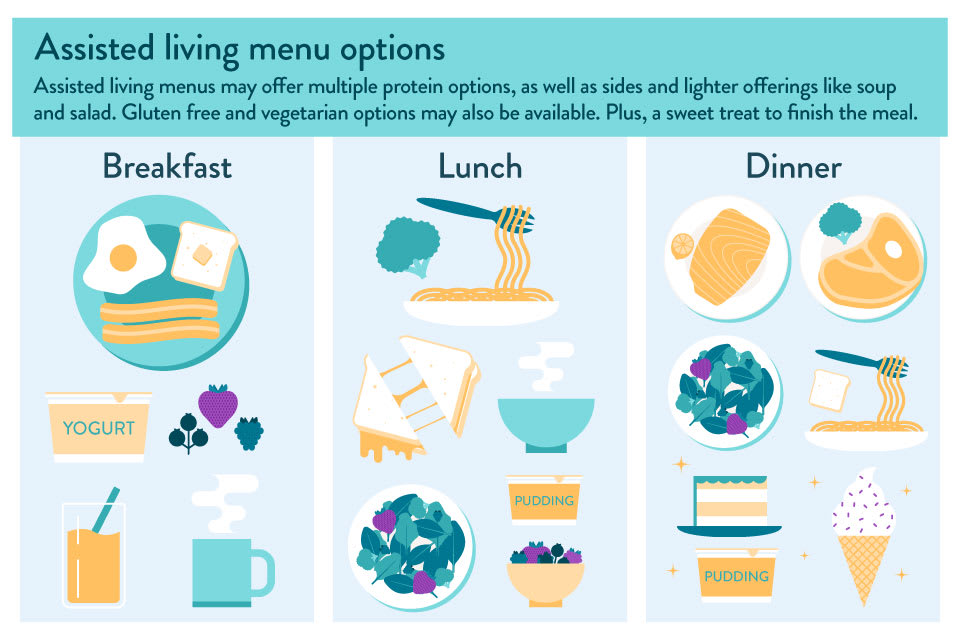
Dishing Up the Facts About Assisted Living Menus and Dining Options

Grilled chicken. Roasted asparagus. Mashed potatoes and gravy. This meal may be accompanied by a basket of fluffy bread and butter on the table, or by chocolate pudding for dessert. “Our main goal is for residents to be satisfied and fulfilled, while keeping them healthy,” says Sam Wright, a cook who’s worked for three Navion communities in Kentucky over the past 16 years. Assisted living menus are based on residents’ personal tastes and nutritional needs — but they also create a sense of community. When people spend time together enjoying a meal, they form bonds that reduce isolation and make residents feel at home.
Is assisted living the right fit?
Let our free assessment guide you to the best senior living options, tailored to your needs.
Key Takeaways
- Assisted living menu options give residents choices. Culinary staff strive to compose menus that cater to all tastes and offer residents a variety of daily selections to enjoy.
- In-room and anytime dining may both be available. However, be prepared for meal delivery outside normal dining hours to come at an extra cost.
- Menus meet the dietary needs of residents. Assisted living chefs incorporate nutritious ingredients to design unique menus that suit senior nutrition needs.
- Assisted living menus now cater to special diets. A full range of options — including vegan, gluten-free, and organic — may be available.
Menu options allow residents the opportunity to choose

The ability to choose daily meals offers assisted living residents autonomy, and it adds to the appeal of restaurant-style dining.
“Navion communities pass out menus at breakfast or lunch so that residents can choose what they want to eat the following day,” says Wright.
And, when residents enter the dining room, staff members are ready to serve their pre-chosen plates.
Menus typically include a variety of options that appeal to all tastes and dietary preferences. Generally, lunch will be the heaviest meal of the day, while dinner will have lighter options for residents who don’t want to eat something more substantial before bed.
The breakfast menu of an assisted living facility may offer these options:
- A traditional “full breakfast” of eggs, toast, and bacon
- A lighter option, like yogurt with berries
- A variety of whole-grain cereals
- Coffee, orange juice, or skim milk
A lunch menu may include the following:
- A hearty option, like beef stroganoff with vegetables
- A quick and classic choice, like grilled cheese on wheat bread with antioxidant-rich tomato soup
- A side salad packed with vegetables and served with a variety of dressings
- A light dessert, like rice pudding or fresh fruit salad
A dinner menu may offer these choices:
- A restaurant-style entree, like grilled salmon or lean steak
- A comfort food, like spaghetti and garlic bread
- A choice of appetizers, like salad, soup, or rolls
- Dessert options, like low-fat ice cream, cake, or sugar-free pudding

Is assisted living the right fit?
Let our free assessment guide you to the best senior living options, tailored to your needs.
In-room and anytime dining offer flexibility
Mealtimes in assisted living communities provide an opportunity for socialization and togetherness. That’s why meals are traditionally served in communal, restaurant-style dining rooms at specified times throughout the day.
However, some seniors may operate on a different schedule, or they may need their meals delivered to their individual rooms or apartments. If your loved one is a night owl who doesn’t wake up in time for breakfast, or if they’re an introvert who prefers alone time, ask communities about in-room and anytime dining when you tour.
These options are generally available, but they may come at a price. Meal delivery outside regular dining hours might incur a surcharge, or it might not offer the same number of options, since it’s crucial for communities to serve fresh, recently prepared dishes.
Assisted living menus meet the dietary needs of residents
Community dining staff design meals to meet the unique nutritional needs of aging adults. In addition to flavor and presentation, chefs focus on including nutrients that seniors require in their diets. By incorporating a wide variety of fresh, natural ingredients, an assisted living menu can combat vitamin deficiencies, improve physical and cognitive health, and help residents maintain strength.
The MIND diet reduces inflammation and may slow cognitive decline
The MIND diet, designed to lower inflammation and bodily stress, can help reduce the likelihood of obesity, heart disease, diabetes, and possibly even cognitive decline, according to the National Institute on Aging.[01] A version of the Mediterranean diet, the MIND (Mediterranean-DASH Intervention for Neurodegenerative Delay) diet was created specifically to promote senior health (DASH stands for Dietary Approaches to Stop Hypertension). It includes the following ingredients:
- Leafy green vegetables
- Whole grains
- Nuts and legumes
- Fish
- Olive oil
- Berries
An assisted living menu might feature these dishes:
- Baked salmon with a side of garlic spinach
- Yogurt with berries
- A tuna fish sandwich on multigrain bread
A diabetic-friendly diet plan can help seniors moderate blood sugar
Residents who have diabetes or are prediabetic can benefit from a diet with limited sugars and refined carbohydrates. A diabetic-friendly diet plan includes the following, according to the American Diabetes Association:[02]
- Lean poultry
- Whole grains and complex starches
- High-fiber vegetables
- Citrus and stone fruits
An assisted living menu sample might include some of the following:
- Grilled chicken with brown rice and broccoli
- A black bean and sweet potato bowl with avocado
- A fruit salad with peaches and cherries
A high-protein, low-calorie diet can help residents struggling with obesity and muscle loss
A diet rich in protein and low in empty calories can help older adults maintain muscle mass and improve bone density, according to research published in the American Journal of Clinical Nutrition.[03] This menu plan, designed to reduce obesity risks, may focus on the following:
- Fruits and vegetables
- Lean proteins
- Dairy
- Eggs
- Seafood
An assisted living menu might offer options like these:
- Low-sodium Chinese beef and broccoli
- A veggie-packed omelet with low-fat cheddar cheese
- A grilled shrimp salad

Assisted living questions? Get expert help
Tell us your care needs to receive personalized guidance from our advisors.
Special-diet menu options may be available
Residents may prefer or require unique options that cater to their preferences or dietary needs. Assisted living communities should work hard to ensure that every senior’s needs are met.
- Grand Living communities offer tasty vegan and vegetarian options, like baked eggplant, pasta with vegetables, and quinoa bowls.
- Many Brookdale communities support the growing trend toward gluten-free diets with celiac-friendly options like gluten-free toast, pastas, and cereals.
- Some Discovery communities offer fresh, fully organic menus to environmentally conscious residents.
- Many Jewish senior living communities include Kosher dining options. These meals may be made off-site in certified Kosher kitchens and delivered to residents.
What to look for in assisted living menus
Food is a vital part of our lives. It’s more than just sustenance and nutrition — it’s an opportunity to connect with others and nourish our spirits.
As you and your loved one search for the right assisted living fit, keep dining in mind. On tours, ask for a copy of the weekly menu, or, if you’re feeling social, see if you can sit down and enjoy a meal with current residents.
Talk with your loved one about their specific needs and interests when it comes to assisted living menus, whether that means vegetarian entrees, a focus on comfort foods, or diabetes management. A Place for Mom’s Senior Living Advisors can work with you to search for which affordable assisted living communities will best fit those needs, all at no cost to you.
National Institute on Aging. (2019, November 27). What do we know about diet and prevention of Alzheimer’s disease?
American Diabetes Association. Eating right doesn’t have to be boring.
Weaver, A. A., Houston, D. K., Shapses, S. A., Lyles, M. F., Henderson, R. M., Beavers, D. P., Baker, A. C., & Beavers, K. M. (2019, February 1). Effect of a hypocaloric, nutritionally complete, higher-protein meal plan on bone density and quality in older adults with obesity: a randomized trial. American Journal of Clinical Nutrition.
Assisted living in all states
The information contained on this page is for informational purposes only and is not intended to constitute medical, legal or financial advice or create a professional relationship between A Place for Mom and the reader. Always seek the advice of your health care provider, attorney or financial advisor with respect to any particular matter, and do not act or refrain from acting on the basis of anything you have read on this site. Links to third-party websites are only for the convenience of the reader; A Place for Mom does not endorse the contents of the third-party sites.
Assisted Living options tailored to your needs
Assisted Living options tailored to your needs